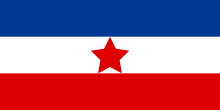
The 13th Waffen Mountain Division of the SS Handschar was a mountain infantry division of the Waffen-SS, an armed branch of the German Nazi Party that served alongside but was never formally part of the Wehrmacht during World War II. At the post-war Nuremberg trials, the Waffen-SS was declared to be a criminal organisation due to its major involvement in war crimes and crimes against humanity. From March to December 1944, the division fought a counter-insurgency campaign against communist-led Yugoslav Partisan resistance forces in the Independent State of Croatia, a fascist puppet state of Germany that encompassed almost all of modern-day Croatia, all of modern-day Bosnia and Herzegovina and parts of Serbia.

Operation Rösselsprung was a combined airborne and ground assault by the German XV Mountain Corps and collaborationist forces on the Supreme Headquarters of the Yugoslav Partisans in the Bosnian town of Drvar in the Independent State of Croatia during World War II. It was launched 25 May 1944, with the goal of capturing or killing Partisan leader Marshal Josip Broz Tito and destroying the headquarters, support facilities and co-located Allied military missions. It is associated with the Seventh Enemy Offensive in Yugoslav history, forming part of the Seven Enemy Offensives historiographical framework. The airborne assault itself is also known as the Raid on Drvar.

The Croatian Home Guard was the land army part of the armed forces of the Independent State of Croatia which existed during World War II.

The Belgrade offensive or the Belgrade strategic offensive operation was a military operation during World War II in Yugoslavia in which Belgrade was liberated from the German Wehrmacht through the joint efforts of the Soviet Red Army, Yugoslav Partisans, and the Bulgarian Army. Soviet forces and local militias launched separate but loosely cooperative operations that undermined German control of Belgrade and ultimately forced a retreat. Martial planning was coordinated evenly among command leaders, and the operation was largely enabled through tactical cooperation between Josip Broz Tito and Joseph Stalin that began in September 1944. These martial provisions allowed Bulgarian forces to engage in operations throughout Yugoslav territory, which furthered tactical success while increasing diplomatic friction.

The Yugoslav Ground Forces was the ground forces branch of the Yugoslav People's Army (JNA) from 1 March 1945 until 20 May 1992 when the last remaining remnants were merged into the Ground Forces of the new Federal Republic of Yugoslavia, under the threat of sanctions.

The 373rd (Croatian) Infantry Division was a division of the German Army during World War II. It was formed in June 1943 using a brigade from the Home Guard of the Independent State of Croatia with the addition of a German cadre. The division was commanded by Germans down to battalion and even company level in nearly all cases, and was commonly referred to as a "legionnaire division". Originally formed with the intention of service on the Eastern Front, it was used instead for anti-Partisan operations in the territory of the NDH until the end of the war. It fought mainly in the western areas of the NDH, and was involved in the attempt to kill or capture the leader of the Partisans, Josip Broz Tito, in May 1944. Severely depleted by desertion, the division withdrew towards the Reich border in the early months of 1945, eventually surrendering to the Partisans on 10 May 1945 near Brežice in modern-day Slovenia.

The Bihać operation was a military operation conducted by Yugoslav partisans against the Independent State of Croatia (NDH) and Nazi Germany during World War II. The aim of the operation was to capture Bihać and the surrounding towns to connect Partisan held areas in Bosanska Krajina, and Knisnka Krajina. The battle for the city of Bihać lasted from 2 November to 4 November 1942. After capturing the city, the partisans continued to fight in surrounding areas until 15 November. The operation resulted in a major Partisan victory, with Bihać and the surrounding areas being captured, and the NDH suffering significant casualties.

The 6th Proletarian Assault Lika Division "Nikola Tesla" was a Yugoslav Partisan division formed on 22 November 1942. It was formed from the 1st, 2nd, and 3rd Lika Brigades. On 11 November 1943, it became part of the 4th Corps and later a part of the 1st Corps. It operated in Dalmatia until November 1943 when it crossed into Bosnia, later it fought in Serbia and on the Syrmian Front. From October 1944, the 22nd Serbian Kosmaj Brigade also fought as part of the division, and in December 1944 an Artillery Brigade was formed within the division.

The 8th Kordun Assault Division was a Yugoslav Partisan division formed in Crevarska Strana on 22 November 1942. Upon on formation it consisted of 4th Kordun Brigade, 5th Kordun Brigade and 6th Littoral-Gora Brigade with total of around 4,200 soldiers. The division was commanded by Vlado Ćetković and its political commissar was Artur Turkulin. It took part in various Partisan operations in Croatia, Bosnia and Slovenia. It was declared an "Assault" division on 16 June 1944 by the Supreme Headquarters.

The 9th Dalmatia Division was a Yugoslav Partisan division formed in Imotski on 13 February 1943. Upon formation it was composed of the 3rd, the 4th and the 5th Dalmatia Brigades. The division fought NDH, Germany, Italy and Chetniks in various operations conducted by the Partisans, it played a key role in the Trieste operation. It was commanded by Ante Banina and its political commissar was Eduard Santini.

The 13th Primorsko-GoranskaAssault Division was a Yugoslav Partisan division formed in Brinje on 19 April 1943. On the day of its formation it consisted of 1,986 soldiers in two brigades: the 6th and 14th Primorsko-Goranska Brigades. Commander of the brigade was Veljko Kovačević while its political commissar was Josip Skočilić. The division mostly operated in the regions of Croatian Littoral and Gorski Kotar. In January 1944, the division became part of the 11th Corps. By the end of the war the division grew in size to around 5,600 soldiers.

The 15th Slovenian Assault Division was Yugoslav Partisan division formed in Dolenjske Toplice on 13 July 1943. Upon formation it had around 1,600 soldiers in three brigades, those being the 4th, 5th and the 6th Slovenia Brigades. First commander of the division was Predrag Jeftić and its political commissar was Viktor Avbelj. Jeftić was killed in action on 30 July 1943 and Rajko Tanasković became the new commander. On 3 October 1943, the division became a part of the 7th Corps.

The 18th Slovenia Division was a Yugoslav Partisan division formed in Zdenska Vas on September 14, 1943. Upon formation it consisted of around 3,350 soldiers in three brigades, those being: the 8th, 9th and 10th Slovenia Brigades. The division was commanded by Rado Pehaček and its political commissar was Janez Hribar - Tone. On October 3, 1943, it became a part of the 7th Corps. The division operated in Slovenia.

The 19th North Dalmatia Division was a Yugoslav Partisan division formed in Biovičino Selo on 4 October 1943. Upon formation it had 3,559 soldiers in three brigades, those being: the 5th, 6th and 7th Dalmatia Brigades. During all of its existence it was a part of the 8th Corps. Commander of the division was Milan Kuprešanin while its political commissar was Petar Babić. The division mostly operated in Dalmatia, Lika and Bosnia.

The 22nd Serbia Division was a Yugoslav Partisan division formed on 22 May 1944 as the 2nd Serbia Division. It was formed from three brigades, those being the 8th, 10th and 12th Serbia Brigades whose total strength was around 2,000 fighters. Commander of the division was Živojin Nikolić Brka while its political commissar was Vasilije Smajević. The division fought mostly in Serbia but it also participated in battles of Syrmian Front and Final Operations.

The 24th Serbia Division was a Yugoslav Partisan division formed on 10 June 1944 as the 4th Serbia Division in Jablanica. It was formed from the 11th and 17th Serbia Brigades which numbered around 2000 fighters in total. Soon after the formation the 13th and the 15th Serbia Brigades were also added to the division. The division was under the direct command of the Supreme Headquarters until 6 September 1944 when it became a part of the 13th Corps. Its commander was Mile Čalović while its political commissar was Dimitrije Vrbica.

The 26th Dalmatia Division was a Yugoslav Partisan division formed on 8 October 1943. It was formed from the 11th, 12th and 13th Dalmatia Brigades. In January 1944, the 13th Dalmatia Brigade left the division while the 1st Dalmatia Brigade joined it. The 3rd Overseas Brigade joined the division in March 1944. The division mostly operated in the Southern Dalmatia where it fought against parts of the 2nd Panzer Army, 118th Jäger Division, 7th SS Division, and 369th Infantry Division.

The 35th Lika Assault Division was a Yugoslav Partisan division formed on 30 January 1944. It was formed from the 1st and 2nd Lika Brigades of Operational Staff for Lika. Lika Partisan Detachment, Plavi Jadran Battalion and an Artillery divizion were also part of the division upon formation, at the time it had 2,262 fighters. It was part of thee 11th Corps and it operated in territory controlled by Independent State of Croatia.

The 40th Slavonia Division was a Yugoslav Partisan division formed on 15 July 1944. It was formed from the 16th Youth Brigade and 18th Slavonia Brigade. The division was part of the 6th Corps and it mostly fought in Slavonia region. Commander of the division until December 1944 was Veljko Kovačević, after him Savo Miljanović served as the commander.

The 5th Krajina Division was a Yugoslav Partisan division formed in Glamočko polje on 9 November 1942.









